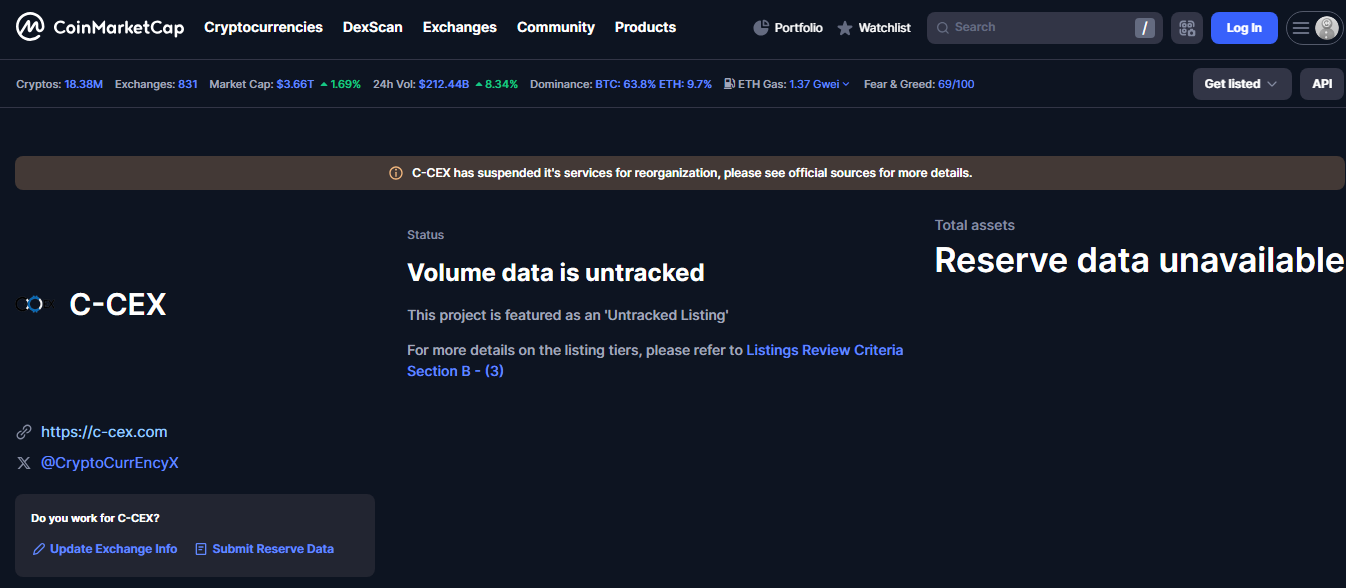C-CEX Exchange Review - A Hollow Shell From Crypto’s Early Days

A brief look back at how C-CEX made a name
C-CEX came on the scene in 2014, launched from the United Kingdom, and quickly found a niche by offering something that was rare at the time - a massive catalog of coins. It listed everything from Bitcoin and Ethereum to obscure micro-caps that barely existed beyond a whitepaper.
For traders back then, this was exciting. Fees hovered around 0.20 %, the sign-up was simple, and almost any small project could apply for a listing. If you were hunting low-volume gems hoping for the next breakout, C-CEX was on the radar.
But the flip side of this free-for-all was a lack of quality control. Many of those listed tokens faded or vanished, leaving thin markets and stranded traders. As competition grew and regulatory expectations tightened across the globe, C-CEX struggled to keep up. It never really modernized, didn’t build deeper liquidity, and eventually slipped into obscurity.
Snapshot table
The old appeal - and how it unraveled
For a window of time, C-CEX filled a role in crypto’s early growth. It gave micro-cap coins a place to trade and let adventurous retail users speculate cheaply. The fees were straightforward, the interface functional, and there was a sense of excitement around trying to catch 10x runs on obscure pairs.
However, problems stacked up. Even at its busiest, many trading pairs suffered from poor depth and huge bid-ask spreads. Moving any serious money through those books was risky - you could watch the price swing 10-15 % on a single moderate order. Meanwhile, traders began demanding more security, proof-of-reserves, and responsive support. C-CEX offered none of that. Over time, user complaints over stuck withdrawals and frozen balances piled up in forums and reviews. By the time global exchanges tightened their compliance standards and transparency became the norm, C-CEX felt like a relic.
Safety, oversight and transparency
One of the biggest knocks on C-CEX is simply how opaque it was - and still is. There’s never been a verified audit or published reserve snapshot. No regulatory filings or clear compliance frameworks either.
The platform somehow avoided major headline hacks, but that’s partly because it never attracted the large deposits seen on bigger venues. Instead, many small retail users took the risk, and some reported losing access to funds due to abrupt wallet maintenance or blocked withdrawals.
That patchy record leaves today’s picture bleak. No serious investor would trust funds to a platform with zero operational data, zero regulatory footprint, and a long backlog of unresolved user issues.
Who it tried to serve - and why that doesn’t work now
C-CEX mostly drew retail speculators chasing obscure altcoins. At the height of the ICO craze, new projects were eager to list anywhere, and C-CEX was relatively open. It was the Wild West: if your token was approved, you could quickly say you were on an exchange.
But this kind of business model only works when traders accept a high level of risk and don’t care about safeguards. As the industry matured, that tolerance evaporated. Modern users look for security audits, deep liquidity pools, insured custodial services and clean compliance. C-CEX offered none of that.
What’s left of its pros and glaring cons
Why people once used it:
- Enormous asset diversity, over 300 pairs at one point
- Easy entry for small-cap coins needing a first listing
- Simple, low fee structure that undercut bigger platforms
Why it’s completely off the map now:
- Zero activity today - no liquidity, no reported trades
- No audits, no reserve data, no compliance transparency
- Persistent old complaints of blocked funds and silent support
- Risks wildly outweigh any benefit in today’s market
- Competing exchanges now deliver better fees, security and volume
The realistic verdict
C-CEX is basically a fossil from crypto’s wilder early days. It once thrived on listing any token that showed up, but never evolved into a transparent, robust operation. As other exchanges brought in tighter security, insurance, and massive liquidity pools, C-CEX just stood still - and ultimately faded.
In 2025, there’s no practical reason to use it. The books are empty, the trust level is nonexistent, and there are hundreds of better venues to trade on, whether you want large-cap stability or to dabble in new DeFi experiments. C-CEX serves as a cautionary tale: exchanges that skimp on transparency and user protections might enjoy a quick boom, but without real foundations, they fade fast.
Disclaimer
“This content is for informational purposes only and does not constitute financial advice. Please do your own research before investing.”
.png)







%203.svg)
%203.svg)




















